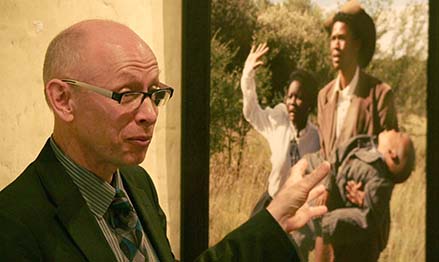 Björn Krondorfer |
The apartheid years. The Anglo-Boer War. Mix these two topics together and you are ensured of a vigorous debate.
This was exactly the result at the Centenary Complex Gallery recently. During a round-table discussion, Kovsie students analysed an artwork by Gerrit Hattingh entitled “Before and After Hector”. The artwork depicts the iconic photo of Hector Pieterson – taken during the 1976 Soweto Uprising – staged as an event in the Anglo-Boer War.
The artwork functioned as the focal point at an exhibition curated by Angela de Jesus.The exhibition formed part of the International Research Forum hosted by the UFS which explored the topic of Societies in the Aftermath of Mass Trauma and Violence.
The ensuing conversation did not disappoint. The photograph evoked a wide range of views and emotions as the students reflected on the historic image representing violent and painful events of our collective past. As the students robustly exchanged their opinions, they developed strategies to support the reconciliation process. The dialogue assisted these students in formulating ways to look back at our history and use this knowledge to carry our society past traumatic experiences.
Prof Pumla Gobodo-Madikizela, Senior Research Professor in the Office for Research on Trauma, Forgiveness and Reconciliation, was astounded at the level of insight and wisdom the students displayed. “I am pleased that our students came to join us around the table to discuss this portrait which is iconic globally; to engage and also give their own interpretations of what they know, and what they do not know about our historical past. The dialogue about the interweaving of the Hector Pieterson photograph with the story of black victims of the British concentration camps is one of the ways of exploring the views of the younger generation in the aftermath of mass trauma and violence in our collective history,” Prof Gobodo-Madikizela concluded at the end of the conversation.